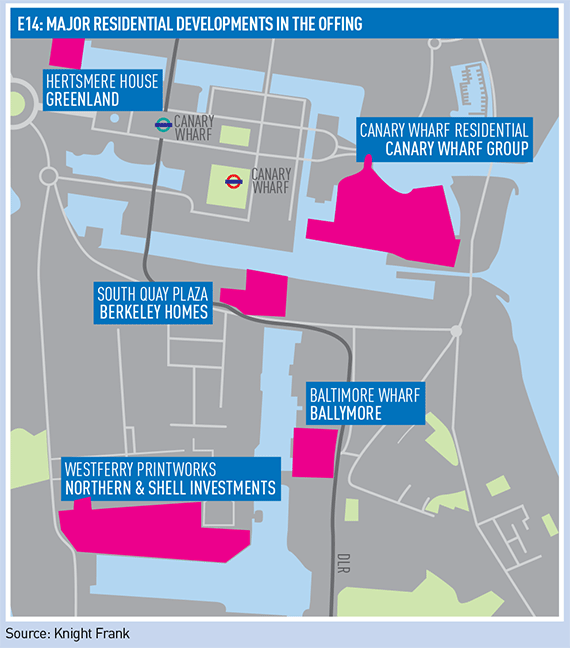Despite the slowdown in the London new-build sales market, there have been major announcements on the Isle of Dogs, E14, since the referendum.
This week, Greenland formally launched the Spire, the tallest residential tower in Europe at 67 storeys, while in July, Chalegrove’s Landmark Pinnacle Tower secured £320m in development finance.
But the residential market around Canary Wharf has often been mentioned in the same sentence as Vauxhall, SW8, particularly with regard to oversupply, and could be set for a slowdown.
The similarities
As in Vauxhall, a huge amount of stock is soon to be delivered. According to EGi Research, more than 16,000 units were in the pipeline at the end of 2015, not far short of the more than 17,000 units south of the river.
It is questionable that the market will be able to absorb those numbers in both locations.
Canary Wharf Group, which is developing 3,300 units at Wood Wharf alongside 335,000 sq ft of shops, has already said it will consider slowing down the development of one or two buildings, to “ensure there is no oversupply of product”.
“I wasn’t perhaps sitting down worrying about the Isle of Dogs so much three or four months ago, but there is a lot of new-build there,” says Johnny Morris, research director at estate agency Countrywide.
“With the Brexit risk to the City, one wonders if it could be a slightly harder sell, mainly from the uncertainty point of view.”
Alongside concerns around oversupply and completions, part of the problem is that the Isle of Dogs has previously been reliant on the financial occupiers in the area, which affect residential demand.
“In the context of the referendum decision, there are concerns about the banking sector, which puts it in a different space, as it needs to be vibrant,” says Adam Challis, head of residential research at JLL.
A potential slowdown in overseas buyers post-referendum could also hit the market, which has been reliant on a large number of pre-sales to fund the towers under construction. Morris says that London-wide Countrywide research shows that the number of overseas buyers has been declining for the past 18 months.
The differences
If the market stutters, development may slow in the near term.
Challis says: “What is likely is that some planned schemes are likely to be delayed. There have already been announcements for a couple of them. That will, as ever, tend to counteract the price sensitivity concerns that people have.”
But unlike Vauxhall, and as a sign of how far the Canary Wharf market has come in the past 10 years, what is keeping agents confident is the character of the area.
Nick Parr, partner at Knight Frank, says it has come a long way in past 15 years, “a lot further west”, and offers a good environment and security for buyers.
He adds that, critically, the night time economy has improved markedly.
“All these things make it a more sophisticated location than somewhere like Vauxhall,” he says.
Canary Wharf Group, which has spent a lot of time improving the public realm, is similarly confident. Head of residential sales Brian De’ath says it has received a positive response to its homes.
“We remain excited about the continued opportunity to offer people the chance to live in a safe and well-managed private estate, with an already established cultural community that will over time evolve and grow,” he says.
The outlook
The market on the Isle of Dogs, like the London new-build market as a whole, is set for tougher times in the coming years, but may be better placed to weather it.
Much will depend on future transport connections, additions to the public realm, and the occupier mix in the office towers.
Challis says that while Crossrail will have an important impact, “more important for demand in that space will be Canary Wharf Group diversifying its occupier base away from just financial, making sure it is an incubator for tech and services – that perhaps more than everything else.”
And of course, a lot could come down to – relative – affordability, at least away from the water. LonRes analysis says that 36%
of properties up for sale in E14 are priced at less than £500,000, compared with just 3.9% in SW8.
Properties sold in the past three months achieved an average of £724 per sq ft in E14 and £1,084 per sq ft in SW8.
• To send feedback, e-mail alex.peace@estatesgazette.com or tweet @EGAlexPeace or @estatesgazette












